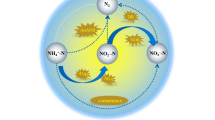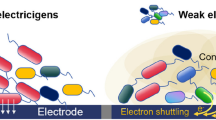Abstract
Carbon monoxide (CO) is one of the common gaseous compounds found in hot volcanic environments. It is known to serve as the growth substrate for a number of thermophilic prokaryotes, both aerobic and anaerobic. The goal of this work was to study the process of anaerobic transformation of CO by microbial communities inhabiting natural thermal environments: hot springs of Uzon Caldera, Kamchatka. The anaerobic microbial community of Treshchinny Spring (80°C, pH 6.5) was found to exhibit two peaks of affinity for CO (K S1 = 54 nM and K S2 = 1 μM). The actual rate of anaerobic CO transformation by the microbial community of this spring, calculated after obtaining the concentration dependence curve and extrapolated to the natural concentration of CO dissolved in the hot spring water (20 nM), was found to be 120 μmol l−1 of sediment day−1. In all the hot springs studied, more than 90% of the carbon of 14CO upon anaerobic incubation was recovered as 14CO2. From 1 to 5% of 14CO was transformed to volatile fatty acids (VFA). The number of microorganisms capable of anaerobic CO oxidation determined by dilution-to-extinction method reached 106 cells ml−1 of sediment. CO-transforming anaerobic thermophilic microorganisms isolated from the springs under study exhibited hydrogenogenic type of CO oxidation and belonged to the bacterial genera Carboxydocella and Dictyoglomus. These data suggest a significant role of hydrogenogenic carboxydotrophic prokaryotes in anaerobic CO transformation in Uzon Caldera hot springs.



Similar content being viewed by others
References
Adams MWW (1990) The structure and mechanism of iron-hydrogenases. Biochim Biophys Acta 1020:115–145
Amend JP, Shock EL (2001) Energetics of overall metabolic reactions of thermophilic and hyperthermophilic archaea and bacteria. FEMS Microbiol Rev 25:175–243
Boulygina ES, Kuznetsov BB, Marusina AI, Tourova TP, Kravchenko IK, Bykova SA, Kolganova TV, Galchenko VF (2002) A study of nucleotide sequences of nifH genes of some methanotrophic bacteria. Microbiology 71:425–432 (English translation of Mikrobiologiia)
Fauque G, Peck HD, Moura JJG Jr, Huynh BH, Berlier Y, DerVartanian DV, Teixeira M, Przybyla AE, Lespinat PA, Moura I, LeGall J (1988) The three classes of hydrogenases from sulfate-reducing bacteria of the genus Desulfovibrio. FEMS Microbiol Rev 54:299–344
Gas–liquid equilibrium (Ravnovesie gas – zhidkost’) (1964) In: Nikol’skii BP, Grigorov ON, Pozin ME, Porai-Koshits BA, Rabinovich VA, Rachinskii FU, Romankov PG, Fridrikhsberg DA (eds) Chemist’s manual (Spravochnik Khimika), 2nd edn, vol 3. Khimiya, Moscow, (in Russian)
Henstra A-M, Dijkema C, Stams AJM (2007) Archaeoglobus fulgidus couples CO oxidation with sulfate reduction and acetogenesis with transient formate accumulation. Environ Microbiol 9:1836–1841
Huber H, Huber G, Stetter KO (1985) A modified DAPI fluorescence staining procedure suitable for the visualization of lithotrophic bacteria. Syst Appl Microbiol 6:105–106
Kevbrin VV, Zavarzin GA (1992) The influence of sulfur compounds on the growth of halophilic homoacetic bacterium Acetohalobium arabaticum. Microbiology (English translation of Mikrobiologiya) 61:812–817
King GM, Weber CF (2007) Distribution, diversity and ecology of aerobic CO-oxidizing bacteria. Nat Rev Microbiol 5:107–118
Kyle JE, Schroeder PA, Wiegel J (2007) Microbial silicification in sinters from two terrestrial hot springs in the Uzon Caldera, Kamchatka, Russia. Geomicrobiol J 24:627–641
Lane DJ (1991) 16S/23S rRNA sequencing. In: Stackebrandt E, Goodfellow M (eds) Nucleic acid techniques in bacterial systematics. Wiley, New York, pp 115–175
Lee HS, Kang SG, Bae SS, Lim JK, Cho Y, Kim YJ, Jeon JH, Cha SS, Kwon KK, Kim HT, Park CJ, Lee HW, Kim SI, Chun J, Colwell RR, Kim SJ, Lee JH (2008) The complete genome sequence of Thermococcus onnurineus NA1 reveals a mixed heterotrophic and carboxydotrophic metabolism. J Bacteriol 190:7491–7499
Parshina SN, Kijlsta S, Henstra AM, Sipma J, Plugge CM, Stams AJM (2005) Carbon monoxide conversion by thermophilic sulfate-reducing bacteria in pure culture and in co-culture with Carboxydothermus hydrogenoformans. Appl Microbiol Biotechnol 68:390–396
Romanek C, Mills G, Zhang C, Jones M, Fiser J, Wiegel J (2005) Stable isotopes as indicators of microbial processes in hot spring environments. In: Abstr International workshop ‘Biodiversity, molecular biology and biogeochemistry of thermophiles’, Petropavlovsk-Kamchatky, Russia
Slepova TV, Rusanov II, Sokolova TG, Bonch-Osmolovskaya EA, Pimenov NV (2007) Radioisotopic tracing of carbon monoxide conversion by anaerobic thermophilic prokaryotes. Microbiology (English translation of Mikrobiologiia.) 76:523–529
Slobodkin AI, Sokolova TG, Lysenko AM, Wiegel J (2006) Reclassification of Thermoterrabacterium ferrireducens as Carboxydothermus ferrireducens comb. nov., and emended description of the genus Carboxydothermus. Int J Syst Evol Microbiol 56:2349–2351
Sokolova TG, Kostrikina NA, Chernyh NA, Tourova TP, Kolganova TV, Bonch-Osmolovaskaya EA (2002) Carboxydocella thermautotrophica gen. nov., sp. nov., a novel anaerobic, CO-utilizing thermophile from Kamchatkan hot spring. Int J Syst Evol Microbiol 52:1961–1967
Sokolova TG, Jeanthon C, Kostrikina NA, Chernyh NA, Lebedinsky AV, Stackebrandt E, Bonch-Osmolovskaya EA (2004) The first evidence of anaerobic CO oxidation coupled with H2 production by a hyperthermophilic archaeon isolated from a deep-sea hydrothermal vent. Extremophiles 8:317–323
Sokolova TG, Henstra AM, Sipma J, Parshina SN, Stams AJM, Lebedinsky AV (2009) Diversity and ecophysiological features of thermophilic carboxydotrophic anaerobes. FEMS Microbiol Ecol 68:131–141
Stupperich E, Fuchs G (1984) Autotrophic synthesis of activated acetic acid from two CO2 in Methanobacterium thermoautotrophicum. Arch Microbiol 139:14–20
Subbotina IV, Chernyh NA, Sokolova TG, Kublanov IV, Bonch-Osmolovskaya EA, Lebedinsky AV (2003) Oligonucleotide probes for the detection of representatives of the genus Thermoanaerobacter. Microbiology (English translation of Mikrobiologiia) 72:331–339
Svetlichny VA, Svetlichnaya TP (1988) Dictyoglomus turgidus sp nov., a new extremely thermophilic eubacterium isolated from hot springs of the Uzon volcano caldera. Mikrobiologiia (in Russian) 57:435–441
Thauer RK, Käufer B, Zähringer M, Jungermann K (1974) The reaction of iron-sulfur protein hydrogenase with carbon monoxide. Eur J Biochem 42:447–452
Wolin EA, Wolin MJ, Wolfe RS (1963) Formation of methane by bacterial extracts. J Biol Chem 238:2882–2886
Acknowledgments
We are grateful to Nadezhda Kostrikina (Winogradsky Institute of Microbiology, Russian Academy of Sciences) for the electron microscopy of the new isolates. This work was supported by the Russian Academy of Sciences Programs ‘Molecular and Cell Biology’ and ‘Origin and Evolution of the Biosphere’, as well as by NSF-funded research grant ‘Microbial Observatory Kamchatka, an International Interdisciplinary Research Project’ (NSF MCB-02238407).
Author information
Authors and Affiliations
Corresponding author
Additional information
Communicated by A. Oren.
Rights and permissions
About this article
Cite this article
Kochetkova, T.V., Rusanov, I.I., Pimenov, N.V. et al. Anaerobic transformation of carbon monoxide by microbial communities of Kamchatka hot springs. Extremophiles 15, 319–325 (2011). https://doi.org/10.1007/s00792-011-0362-7
Received:
Accepted:
Published:
Issue Date:
DOI: https://doi.org/10.1007/s00792-011-0362-7




